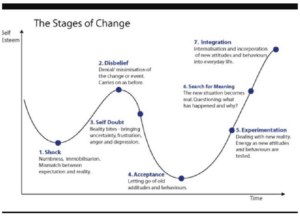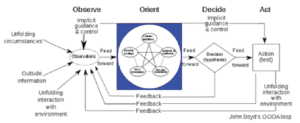Hello,
We begin today with a couple of comments on our collective state of mind, and on a decision-making construct we find helpful, before concluding with an update to our three possible scenarios from a month ago.

From talking to clients, and amongst ourselves, it feels like there was a collective realization in America this week that the household isolation could go on for a while—at least through April. As more states implement stay at home restrictions, upwards of 90% of the US population is now covered by such an advisement. Without being psychologists ourselves, we feel that this illustration showing the mental stages of change fits pretty well with what we have been hearing from people. As a country we are collectively realizing and grieving for what has been lost—hopefully not anyone’s loved ones but, more simply, our daily lives have changed. This isn’t a snow day and we aren’t going back to normal “in a couple of days.” Kids are home from college, homeschooling is happening in our kitchens, vacations have been cancelled, no more social activities, weddings are being postponed or held without family and friends, and on and on. Collectively we put the country somewhere between stages “3-4” as we adapt and begin searching for our new reality.

We also wanted to share with you a way to think about what you are seeing in the news–an organizing framework to help make sense of the endless stream of stories. If nothing else, it may give you a new trivia question for your video chats with friends and family! Air Force Colonel John Boyd is credited with creating “The OODA Loop”. That stands for observe–orient–decide–act and was a process-oriented decision-making construct for military leaders facing an opponent in the field. The approach explained how the speed of decision making could overcome an opponent with the goal being to build an organization that could quickly determine what was important in a chaotic situation, make a decision and implement it, and then immediately gather feedback. Then they could determine what was working and what was not, make new decisions and start the process over again. While developed by an Air Force officer, the US Marine Corps perhaps most effectively exemplified its way of thinking.
Some basic tenets were that, as the nineteenth-century Prussian military commander Helmuth van Molke said, “No plan survives first contact with the enemy”. Things are going to be wrong. Things are not going to work. Things are going to have to be changed. That is ok, in fact it should be expected. The military has had decades of practice institutionalizing this kind of thinking and they still don’t get it right every time. Now think for a moment about any government bureaucracy. Does quick decision making, flexibility and a lack of blame come to mind? Probably not. As you watch your local mayor, governor, CEO, congressman or president make decisions in this crisis, try to view it through this framework. New information is coming in and they are making decisions and watching the data. Take the “Masks/No Masks” question that is now bubbling up. Should we wear masks in public if we are not sick? Currently it is a “no” but maybe it will become a “yes”. Don’t look to assign blame or how someone “got it wrong” or “should have known”. Instead, try to look at it like people are doing the best they can in a chaotic situation and reacting to new information. In this era of Twitter and constant news cycles, we sometimes overemphasize the speed at which things can actually be accomplished. We have found that to be a helpful construct to use to filter the endless barrage of news.
When this is all over a “9/11” type commission would be helpful for the county—not to assign blame but to make the system better for the next time and to collectively learn some lessons. Hindsight is always 20/20. To complete the OODA loop story, in the military they call this meeting a “hotwash” or “after action report” where all the impacted parties get together after the battle is over to dissect how it went from all sides. What could be better? Are there any systemic problems that can be fixed? The 9/11 commission found that local police and fire departments had a hard time communicating as they used separate radio systems and didn’t practice joint operations often. They found that the US intelligence community was very fractured and that air passenger screenings had weaknesses. Today we have new processes and new institutions that help fight terrorism—we’re confident the US will learn lessons from this crisis as well and emerge stronger. It won’t be pretty or without its petty arguments, but it will happen. We would not bet against the imagination and determination of the American people. It may take us awhile to get going, but once we do, historically we have been unstoppable.
Switching gears from the intangible to the tangible, and now that the Procyon Investment Committee has new information, let’s now look at an update to our three economic scenarios – our base case, unfavorable case and optimistic case. All three are primarily driven by the possible paths of the virus and our collective reactions to it.
Base Case 65% probability: Our odds of the base case occurring improved from a month ago. Healthcare – We have been moderately successful in flattening the curve as the social distancing slowly takes effect across increasing parts of the country. This should lead to an easing on healthcare staff in the coming weeks. Less initially impacted areas learn from early hot zones and there is a sharing/movement of resources. Testing availability, speed, and applications improve. Though there are flare-ups as life resumes in the summer, the virus begins to fade. Unfortunately, the virus does take a meaningful toll on human lives. Economic – large scale fiscal and monetary intervention continues. We experience a short, yet meaningful decline in 2Q20 GDP and a likely 2020 recession. The recovery will be volatile and categorized as a “W” shaped recovery before returning to modest growth in 2021. The stock market bottoms ahead of the peak infection rate, with a moderate decline to earnings along with dividend cuts. The recovery is influenced by jitters surrounding further outbreaks. Unemployment numbers will shoot dramatically higher and then peak in the coming months as the CARES act makes its way to those in need and the economy begins to restart. The political system, awake to the dangers, continues to function effectively albeit with the continued partisanship. Gatherings – As society makes new habits, we feel that our economy and citizens will be successful in adapting to the new normal. Some things will go back to normal while other “new habits” may persist, presenting challenges to some businesses and new opportunities for others.
Unfavorable Case 15% probability: Our odds of an unfavorable case are not zero but drop slightly from a month ago after seeing federal action, improvements in other countries, and US state reactions. Healthcare: The social distancing effort was begun in too fragmented a manner or restarted too soon to effectively flatten the curve. The virus overwhelms the healthcare system in most states, fails to be seasonal or has a material resurgence in the fall. Mental health becomes an ongoing issue for many. Economic – A deep lasting recession occurs as social distancing is in place for many months and businesses fail while waiting to get restarted and the ineffective government response fails to help the unemployed. It is characterized as an “L” shaped recovery meaning it takes a while. Market – Continued selling across equities goes to a new low, significant selling in fixed income as well as major stress on balance sheets leading to large scale dividend cuts and some insolvencies. Employment: Continued significant layoffs in the small business sector, now moving into larger corporations as demand shifts. Unemployment is slow to decline as a self-reinforcing drop in demand occurs. Mental health becomes an ongoing issue for many. Gatherings: Citizens prefer not to gather due to lack of confidence or government orders. Schools, sports and other events do not resume as expected in September. Resumption of normal social activity takes far longer than initially expected. The political system shows cracks from the stress.
Optimistic Case 20% Probability: Our odds for our optimistic case remain the same as they were in early March and slightly higher than the unfavorable case. Healthcare facilities begin to see personal protective equipment arriving in time as new supply chains and increased cooperation comes online. Lessons learned from early hot spots command effective responses from other areas allowing for a more effective flattening of the curve. The virus proves seasonal and does not return in the Fall due in part to increased global health care coordination. New testing, treatment, and vaccinations are discovered and brought online faster than currently expected. Economic – The government fiscal and monetary efforts prove adaptable and in scale and pace with the crisis. They prove effective in acting as an insurance policy for impacted people and businesses allowing them to successfully restart the economy by the summer. We would see a sharp “V” shaped recovery in GDP and economic activity as suppressed demand drives growth in a sharp upward direction. Market – The March lows prove to be a bottom in equities, small cap stocks lead the recovery. Employment – Unemployment claims initially spike but begin to decline as business resumes. Gatherings – Life resumes with some positive societal changes taking place after the forced shutdown. We learn lessons from the crisis to make the country more prepared, less political, and more caring in the future. “I remember when gas was $2/gallon” stories flourish.
As Winston Churchill is alleged to have said, “You can always count on Americans to do the right thing, after they have tried everything else.” While people are dying and this is a very serious event in everyone’s life do not lose faith in our collective spirt, ingenuity and determination.
Be Well. Be Informed. Be Not Afraid.
Download PDF BACK